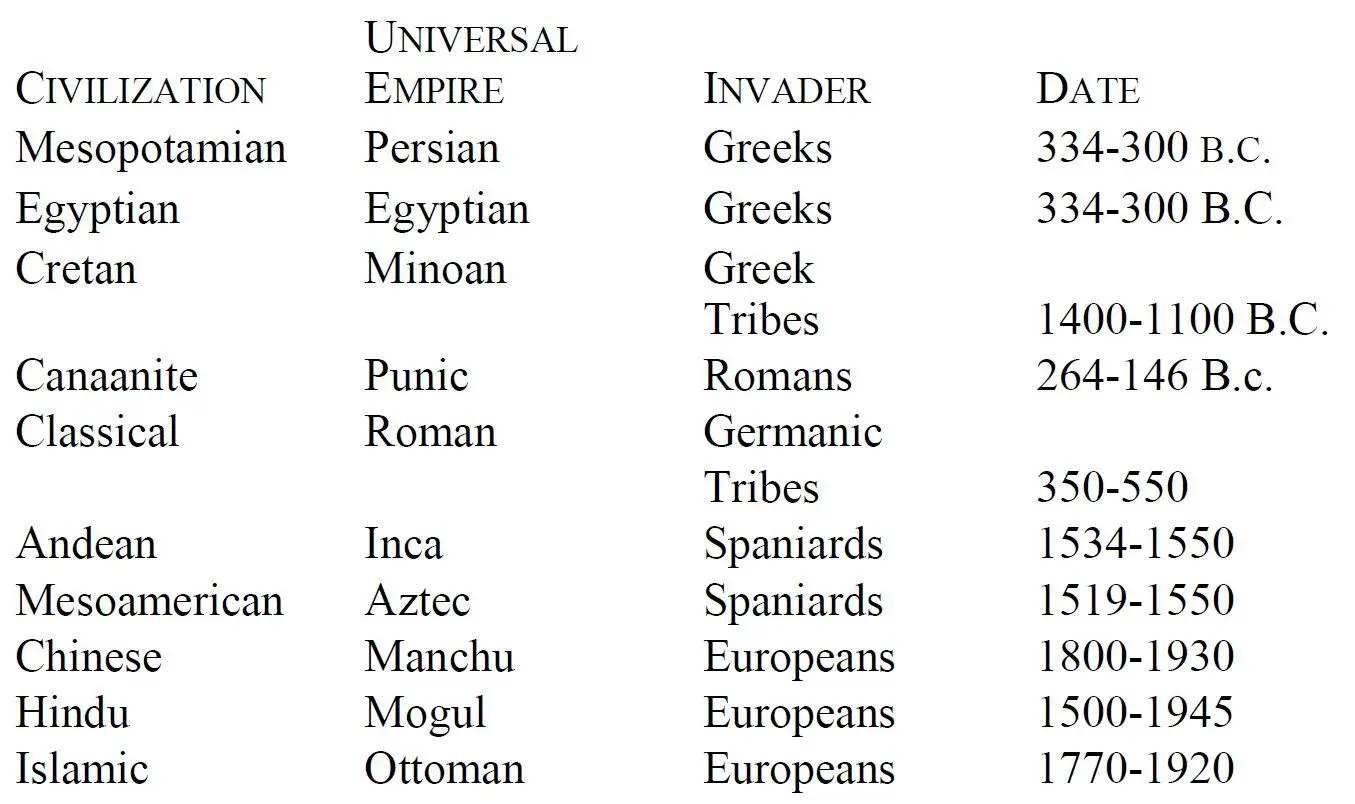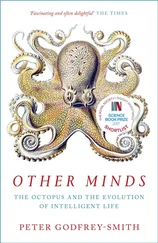The Stage of Decay is a period of acute economic depression, declining standards of living, civil wars between the various vested interests, and growing illiteracy. The society grows weaker and weaker. Vain efforts are made to stop the wastage by legislation. But the decline continues. The religious, intellectual, social, and political levels of the society begin to lose the allegiance of the masses of the people on a large scale. New religious movements begin to sweep over the society. There is a growing reluctance to fight for the society or even to support it by paying taxes.
This period of decay may last for a long time, but eventually the civilization can no longer defend itself, as Mesopotamia could not after 400 B.C., as Egypt could not about the same time, as Crete could not after 1400 B.C., as Rome could not after A.D. 350, as the Incas and Aztecs could not after 1500, as India could not after 1700, as China could not after 1830, and as Islam could not after 1850.
Stage 7 is the Stage of Invasion, when the civilization, no longer able to defend itself because it is no longer willing to defend itself, lies wide open to "barbarian invaders." These invaders are "barbarians" only in the sense that they are "outsiders." Frequently these outsiders are another, younger, and more powerful civilization. The following list of universal empires shows the barbarian invader that destroyed the civilization in question:

As a result of these invasions by an outside society, the civilization is destroyed and ceases to exist. This Stage of Invasion is also a period of mixture. As such, it may be, but does not need to be, Stage 1 of a new civilization. This condition was true of several of the invasions listed above. The invasions of the Greek tribes, which ended Minoan civilization, marked Stage 1 of Classical civilization; the invasions of the Germanic tribes, which ended Classical civilization, marked Stage 1 of Western civilization.
The seven stages are merely a convenient way of dividing a complex historical process. This process is not relentlessly deterministic at all points but merely at some points, in the sense that men have power and free will but their actions have consequences nevertheless. In general, if cultural mixture produces a new producing society with an instrument of expansion we have Stage 1 of a civilization. Stages 2, 3, and 4 will follow inevitably. This means that, if a producing society has an instrument of expansion, saving and investment will lead to expansion, and this expansion will eventually slow up as the instrument becomes an institution. At this point, in the early part of Stage 4 there is considerable freedom since the institutionalized instrument of expansion may be reformed or circumvented. If it is, expansion will be resumed, and the civilization will again be in Stage 3. If it is not reformed or circumvented, reaction will triumph, and the crisis will become worse. The choice between reform and reaction is not, however, a rigid one. The last part of Stage 3 may be a continual series of minor reforms and circumventions to the point where the creation of new instruments just about balances the institutionalization of old instruments and expansion continues at a fair rate for a considerable time. Circumvention, especially geographic circumvention, may force institutions that would not otherwise have reformed to do so in order to compete. Thus, for example, as the textile industry of New England became institutionalized, new, more modern plants grew up in the South; the existence of these southern plants (a case of geographic circumvention) forced the textile mills of New England either to modernize or to perish. On a more dramatic scale the whole industrial system of England, in recent times, has been in an institutionalized condition and has been faced with the choice of reforming, thus creating new economic activities and new economic organizations, or perishing from the competition of peripheral areas, like the United States, or semi peripheral areas, like Germany (or even other civilizations, like Japan or India).
Because of such conditions as these, the whole first part of the Age of Conflict (Stage 4) is a period of crisis and of hope. Only when the vested interests create new instruments of class oppression, of imperialist wars, and of irrationality, and when these new instruments, in turn, begin to become institutions, does hope fade. Crisis becomes endemic in the civilization, and continues until the universal empire with its golden age is established. In those civilizations that had a single political unit from an earlier stage, like Egyptian, Minoan, or Orthodox civilization, the Age of Conflict is frequently of briefer duration because imperialist wars are of limited extent. The fact that these one-state civilizations frequently have a socialist state as their instrument of expansion also serves to obscure the duration of the Age of Conflict because such a civilization has weak incentives to invent in its Age of Expansion and less dramatic class conflicts in its Age of Conflict, thus serving to obscure the transition from one of these stages to the other.
In theory there is nothing rigid about Stage 5. So far as observations of past civilizations indicate, every civilization passes from the Age of Conflict to the Age of Universal Empire. That means that one state, probably a peripheral one, emerges triumphant over the whole area of the civilization. But in theory it is at least conceivable that the competing states of Stage 4 might just fight each other down and down to lower and lower levels of prosperity and public order without one emerging triumphant over all the others. In such a case, Stage 5 might be omitted, and the civilization would pass directly from Stage 4 to Stage 6 (Conflict to Decay) without achieving any universal empire. Something like this may have been true of Mesoamerican civilization. In a similar way, it is conceivable, in theory, that a civilization could continue for a very long time in the Stage of Decay without passing on to Stage 7. For there can be no invasion to end the civilization unless there are invaders to come in. Egypt, for example, was so well protected by seas and deserts against invaders that its Stage of Decay lasted for more than a thousand years. It is also, in theory, conceivable that some universal empire someday might cover the whole globe, leaving no external "barbarians" to serve as invaders.
This point leads to one final consideration, namely, the relationship of outside societies to any civilization. In theory again, it would seem that an outside society that was stronger than a given civilization might at any time come in and smash it. In practice, however, it seems that civilizations are in little danger of such an experience except early or late in their careers. In general, a civilization is in no danger from any society except another civilization from Stage 2 to Stage 6. In Stage 6, however, it is in danger from any society, even a parasitic one, as is clear from the destruction of Cretan, Classical, Hittite, and Sinic civilizations by noncivilized invaders. When two civilizations collide we may use the tentative rule that the victory will go to the one that is closer to Stage 3 (Expansion) but that neither one will be destroyed unless it is in Stage 6. In 492-479 B.C. Classical civilization, in Stage 3, and Mesopotamian civilization, in the last part of Stage 5, collided, and the former won; in 336-323 they collided again, with Classical in Stage 4 and Mesopotamian in Stage 6, and the latter was destroyed. In 264-146 B.C. Classical civilization in Stage 4 met Canaanite civilization in Stage 6, and destroyed it. In 711-814 Western civilization in Stage 2 was able to preserve itself against Islamic civilization in Stage 3; three hundred years later, in what we call the Crusades, Western civilization in Stage 3 returned the visit to Islamic civilization, then in Stage 4, but could not destroy it. However, in 1850-1920, Western civilization, just reaching the end of Stage 3, again collided with Islamic civilization, now in Stage 6, and destroyed its universal empire, the Ottoman Empire, and probably liquidated the whole civilization, a process that is still going on. This was only one of several civilizations that were in a similar stage and that have met, or appear to be now meeting, a similar fate. The other universal empires in Stage 6 that have been destroyed by Western civilization while in Stage 3 are the Inca, the Aztec, the Manchu, the Mogul (in India), and perhaps the Tokugawa (in Japan). At the present time India seems to be in Stage 2 of a new civilization; China may be in Stage 1 of a new civilization; while the situation in Japan and in the Near East is still too chaotic to make any judgments about what is happening. Russian civilization, which began about A.D. 500 and had its period of expansion about 1500-1900, had the state as its instrument of expansion and was just entering upon Stage 4 in 1917 when the reform of this institution gave it a new instrument of expansion. As a result, Russian civilization has been in Stage 3 for the second time in recent years, but it remains a relatively weak civilization because of its weak incentives to invention.
Читать дальше











